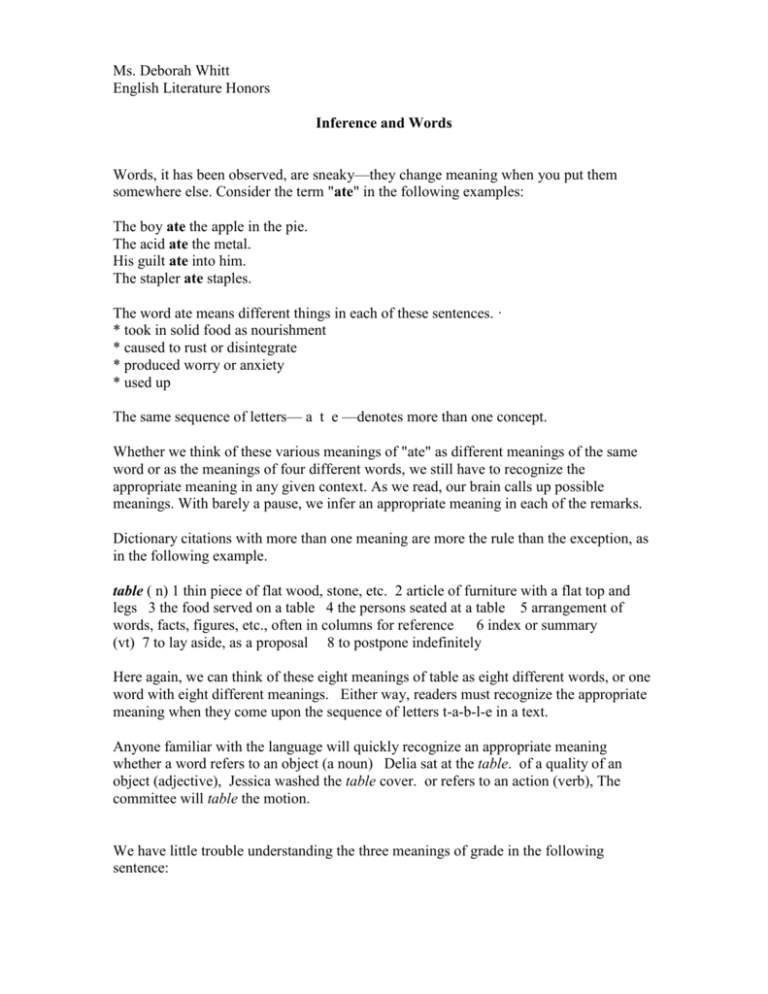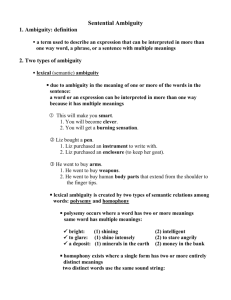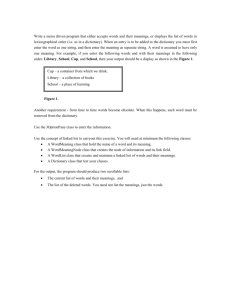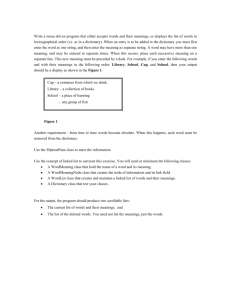Words, it has been observed, are sneaky—they change meaning
advertisement

Ms. Deborah Whitt English Literature Honors Inference and Words Words, it has been observed, are sneaky—they change meaning when you put them somewhere else. Consider the term "ate" in the following examples: The boy ate the apple in the pie. The acid ate the metal. His guilt ate into him. The stapler ate staples. The word ate means different things in each of these sentences. · * took in solid food as nourishment * caused to rust or disintegrate * produced worry or anxiety * used up The same sequence of letters— a t e —denotes more than one concept. Whether we think of these various meanings of "ate" as different meanings of the same word or as the meanings of four different words, we still have to recognize the appropriate meaning in any given context. As we read, our brain calls up possible meanings. With barely a pause, we infer an appropriate meaning in each of the remarks. Dictionary citations with more than one meaning are more the rule than the exception, as in the following example. table ( n) 1 thin piece of flat wood, stone, etc. 2 article of furniture with a flat top and legs 3 the food served on a table 4 the persons seated at a table 5 arrangement of words, facts, figures, etc., often in columns for reference 6 index or summary (vt) 7 to lay aside, as a proposal 8 to postpone indefinitely Here again, we can think of these eight meanings of table as eight different words, or one word with eight different meanings. Either way, readers must recognize the appropriate meaning when they come upon the sequence of letters t-a-b-l-e in a text. Anyone familiar with the language will quickly recognize an appropriate meaning whether a word refers to an object (a noun) Delia sat at the table. of a quality of an object (adjective), Jessica washed the table cover. or refers to an action (verb), The committee will table the motion. We have little trouble understanding the three meanings of grade in the following sentence: You’ve made the grade when promoted to a new grade as a reward for achieving passing grades. You’ve made the grade(overcome a barrier, been successful) when promoted to a new grade(level) as a reward for achieving passing grades(evaluations, marks). From a variety of possible meanings, we infer the meaning appropriate for the given context. We read ideas, not words. We can "fix" a car, a race, a meal, a dye, a cat, or a ship's course. In each instance we do something different. Consider another example: Blackberries are red when they are green. You can almost feel wheels grinding in your head as you do an initial double take before recognizing that, in this context, green does not denote a color, but "unripe." In similar manner, we fill in the appropriate meanings of used in the for-sale advertisement: Used gun. Used for protection. Never been used. Does a reference to a ghetto refer to urban hood or European religious enclave? In each instance, the surrounding discussion provides clues for inferring the appropriate denotation. Ambiguity The fact that common words tend to have multiple meanings can lead to ambiguity, a situation in which two or more equally legitimate readings exist. In many instances, any potential ambiguity is easily resolved. The kids played in the snow. Here snow is obviously a reference to frozen water, not heroin (well, in most contexts!). When more than one meaning of a word makes sense, we have lexical (i.e., referring to words) ambiguity. The school had many poor students on scholarships. Are the students on scholarship "not rich" or "not good students"? The sentence is ambiguous. Readers draw on prior knowledge and past experience to infer the appropriate meaning. They at once "read" both the language and their knowledge of the world. Some of the most striking examples of ambiguity of word meaning can be seen in headlines. Bundy Beats Date With Chair At first glance, this headline refers to an attack by an irate suitor. date = person of opposite sex with whom one has a social engagement chair = household furniture In the context of the news at the time, the headline referred to a convicted killer's scheduled execution. date = appointment chair = electric chair Readers infer word meanings consistent with the surrounding discussion. They infer meaning from contextual clues, whether on the page or, in this case, from our prior knowledge and the news of the day. Examples such as this make clear that we do not simply read words so much as interpret them. In many, if not most, instances, one meaning is obviously the intended meaning within the given context, the other meaning is a somewhat funny alternative meaning. The painting was found by the tree. “By” can mean "near," or "through the agency of." It is unlikely the tree did the finding. This example, however, involves more than simple lexical ambiguity. We also parse the sentence differently to see the different meanings, as the following suggests. The painting was found by the tree. The painting was found by the tree It was next to the tree. The tree found it. When the ambiguity lies in how we analyze a sentence, rather than in deciding the meaning of a word, we have syntactic ambiguity. We saw a clear case of syntactic ambiguity in Chapter One: He did not marry her because he loved her. The meanings depend on how you analyze the sentence. The following headlines provide examples of ambiguity. 1. Drunk Gets Nine Months in Violin Case 2. Iraqi Head Seeks Arms 3. Prostitutes Appeal to Pope 4. Kids Make Nutritious Snacks 5. New Vaccine May Contain Rabies 6. New Study of Obesity Looks for Larger Test Group 7. Include your Children when Baking Cookies 8. Police Begin Campaign to Run Down Jaywalkers 9. Red Tape Holds Up New Bridge 10. Local High School Dropouts Cut in Half Identify which word in each sentence has multiple meanings.








